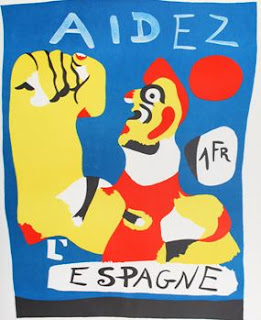 work for his friends in the group Adlan (Amigos de la arte Nuevo – Friends of the new art), a group devoted to modern Spanish art and architecture, and one the groups to organize the monographic show of Picasso in Spain. According to Dupin, Kandinsky and Hélion also contributed work for portfolios sponsored by the group.
work for his friends in the group Adlan (Amigos de la arte Nuevo – Friends of the new art), a group devoted to modern Spanish art and architecture, and one the groups to organize the monographic show of Picasso in Spain. According to Dupin, Kandinsky and Hélion also contributed work for portfolios sponsored by the group. This screen-printed pochoir, from an original gouache (pictured right) dating from the same year, is one of several works in this medium executed by Miro in the years leading up to the Spanish Civil War, each dealing more directly with the effects of the war. It prefigures Miro’s response to the massacre at Guernica, a large painting which hung with Picasso’s famous canvas in a show of solidarity with their home country.
 Pochoir is a print medium akin to silkscreen, in which stencils formed in zinc sheets demarcate mostly flat color fields with strong edges. Many of his pochoirs were executed during his “savage” period, beginning in 1934 as the political situation in Spain began to deteriorate. Dupin, in his catalogue raisonne produced with the artist, notes the pochoir created for D’aci I d’alla (pictured left) stating “the violence of the pure tones harmonizes with the cruel distortion of the forms translating the feeling of terror gripping the bodies at the approach of the great disturbances which have been threatening.”
Pochoir is a print medium akin to silkscreen, in which stencils formed in zinc sheets demarcate mostly flat color fields with strong edges. Many of his pochoirs were executed during his “savage” period, beginning in 1934 as the political situation in Spain began to deteriorate. Dupin, in his catalogue raisonne produced with the artist, notes the pochoir created for D’aci I d’alla (pictured left) stating “the violence of the pure tones harmonizes with the cruel distortion of the forms translating the feeling of terror gripping the bodies at the approach of the great disturbances which have been threatening.”
Miro left Spain in 1936, after the outbreak of civil war in July, and remained away until 1940. While he had been living primarily abroad for some time, he was unable to return to his homeland in Catalonia. Caught without a studio, 
Since 1934 his work was populated with increasingly distorted depictions of the extreme anxiety and distress of those oppressed by the oncoming civil war. But it was not until 1936 that his work began to exhibit a more direct approach to events. Femme et Chien Devant la Lune was one of the earlier manifestations of a contorted citizen wailing to the sky, of the type later to be seen in his own and Picasso’s work during the war. The bold, flat fields of color were emblematic of both his work of the period and the physical considerations of the medium. That they were intended to evoke an emotional response to the situation is emphasized by the next pochoir he created.
Aidez l’Espagne (pictured above) appeared in Cahiers d’Art 12, nos. 4-5, and art review which in the face of the impending crisis devoted multiple issues to Spain. This issue featured a poem on Guernica by Éluard and Picasso’s Songe et mensonge de Franco (Dream and Lie of Franco), and was to raise funds for the Republican forces. Miro’s contribution is a pochoir in the style of Femme et Chien Deavant la Lune, in a more hopeful vein, and was accompanied by Miro’s hopes against the disaster for his country. His handwritten caption for the print read: “In the present conflict I see the decrepit forces of the fascists, and on the other side the people, whose vast creative resources will five Spain a strength that will 
If Femme et Chien Devant la Lune is reflected stylistically in Miro’s other pochoir, perhaps the ultimate compositional corollary his canvas painted in what amounted an international display Spanish artists against fascist Spain. The Reaper, created in 1937 for the Spanish Republican Pavilion at the Paris World’s Fair, was lost after the exhibition. It is 

No comments:
Post a Comment